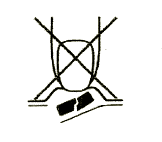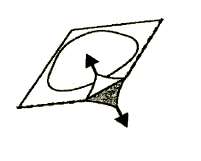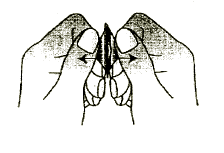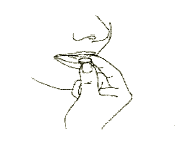
Mirtor
Ask a doctor about a prescription for Mirtor

How to use Mirtor
Package Leaflet: Information for the Patient
Warning! The leaflet should be kept. Information on the immediate packaging in a foreign language.
Mirtor, 30 mg, Oral Disintegrating Tablets
Mirtazapine
Before Taking the Medication, Carefully Read the Contents of the Leaflet, as it Contains Important Information for the Patient.
- The leaflet should be kept so that it can be read again if necessary.
- In case of any doubts, the doctor or pharmacist should be consulted.
- This medication has been prescribed for a specific person. It should not be given to others. The medication may harm another person, even if the symptoms of their illness are the same.
- If the patient experiences any side effects, including any not listed in this leaflet, they should inform their doctor, pharmacist, or nurse. See section 4.
Table of Contents of the Leaflet:
- 1. What is Mirtor and what is it used for
- 2. Important information before taking Mirtor
- 3. How to take Mirtor
- 4. Possible side effects
- 5. How to store Mirtor
- 6. Contents of the package and other information
1. What is Mirtor and what is it used for
Mirtor belongs to a group of medications known as antidepressants.
Mirtor is used to treat depression in adults.
Mirtor starts working after 1-2 weeks of use, and after 2-4 weeks, there is an improvement in well-being. If after 2-4 weeks of treatment, there is no improvement or the patient feels worse, they should consult their doctor. More information is provided in section 3 under "When can improvement in well-being be expected".
2. Important information before taking Mirtor
When not to take Mirtor:
- if the patient is allergic to mirtazapine or any of the other ingredients of this medication (listed in section 6). In such a case, before taking Mirtor, the doctor should be contacted as soon as possible.
- if monoamine oxidase inhibitors (MAOIs) have been used currently or in the recent past (within the last 2 weeks).
Warnings and precautions
Before starting to take Mirtor, the doctor or pharmacist should be consulted.
Before starting to take Mirtor, the doctor should be informed:
If the patient has ever had a severe skin rash or skin peeling, blisters, and (or) ulcers in the mouth after taking Mirtor.
Children and adolescents
Normally, Mirtor should not be used in children and adolescents under 18 years of age, as its effectiveness in this age group has not been established. It should also be noted that in patients under 18 years of age, there is a higher risk of side effects, such as suicidal attempts, suicidal thoughts, and hostility (mainly aggression, rebellious behavior, and anger), when they take medications of this class. Nevertheless, the doctor may prescribe Mirtor to patients of this age if they consider it to be in their best interest. If the doctor has prescribed Mirtor to a patient under 18 years of age, and any doubts arise, the doctor should be consulted. In the case of patients under 18 years of age taking Mirtor, the doctor should be informed if any of the above symptoms develop or worsen. The long-term effect of Mirtor on safety regarding growth, maturation, and cognitive development in this age group has not been established. Additionally, in this age group, after taking mirtazapine, significant weight gain has been observed more frequently than in adult patients.
Suicidal thoughts and depression worsening
Patients with depression may sometimes have thoughts of self-harm or suicide.
Such symptoms or behavior may worsen at the beginning of treatment with antidepressants, as these medications usually start working only after about 2 weeks, sometimes later.
These symptoms are more likely in:
- patients who have previously had thoughts of self-harm or suicide;
- young adult patients. Data from clinical trials show an increased risk of suicidal behavior in people under 25 years of age with mental disorders who were treated with antidepressants. If suicidal thoughts or thoughts of self-harm occur, the doctor should be contacted immediately or the patient should go to the hospital.
It may be helpful to inform relatives or friendsabout the depression and ask them to read this leaflet. The patient may ask them to inform them if they notice that the depression or anxiety has worsened or if there are worrying changes in behavior.
Also, when taking Mirtor, special caution should be exercised
- If the following conditions occur or have occurred: (The doctor should be informed about the occurrence of the following diseases before starting Mirtor if the patient has not done so before.)
- epileptic seizures. If seizures occur or their frequency increases during treatment, the medication should be discontinued and the doctor should be contacted immediately;
- liver disease, including jaundice. If jaundice occurs, the medication should be discontinued and the doctor should be contacted immediately;
- kidney disease;
- heart diseaseor low blood pressure;
- schizophrenia. The doctor should be contacted immediately if such psychotic disorders as paranoid symptoms worsen or increase in frequency;
- manic depression(alternating periods of elevated mood/excitement and depression). If there is a feeling of excessive excitement, the medication should be discontinued and the doctor should be contacted immediately;
- diabetes(it may be necessary to change the dose of insulin or other hypoglycemic medications);
- eye diseases, such as increased intraocular pressure (glaucoma);
- urination difficulties, which may result from prostate enlargement;
- certain heart disordersthat can cause changes in heart rhythm, recent myocardial infarction, heart failure, or the use of certain medications that can cause disturbances in heart rhythm.
- If symptoms of infection occur, such as unexplained high fever, sore throat, and mouth ulcers, the medication should be discontinued, and the doctor should be consulted immediately, and a blood morphology test should be performed. In rare cases, these symptoms may be a sign of blood cell production disorders. These symptoms are rare and usually occur after 4-6 weeks of treatment.
- Patient's in old age are often more sensitive, especially to the side effects of antidepressants.
- Severe skin reactions, including Stevens-Johnson syndrome (SJS), toxic epidermal necrolysis (TEN), drug reaction with eosinophilia and systemic symptoms (DRESS), have been reported during treatment with mirtazapine. If the patient notices any of the symptoms described in section 4 related to these severe skin reactions, they should immediately stop taking the medication and consult a doctor. If the patient has ever had severe skin reactions in the past, they should not restart treatment with mirtazapine.
ciężkimi reakcjami skórnymi, należy natychmiast przerwać stosowanie leku i zasięgnąć porady
lekarza. Jeśli u pacjenta wystąpiły kiedykolwiek w przeszłości jakiekolwiek ciężkie reakcje
skórne, nie należy wznawiać leczenia mirtazapiną.
Mirtor and other medications
The doctor or pharmacist should be informed about all medications the patient is currently taking or has recently taken, as well as any medications the patient plans to take.
Mirtor should not be used in combination with:
- monoamine oxidase inhibitors (MAOIs), nor before 2 weeks have passed since the last dose of MAOI. MAOIs should not be started before 2 weeks have passed since the last dose of Mirtor. MAOIs include moclobemide, tranylcypromine (antidepressants), and selegiline (used in the treatment of Parkinson's disease).
Caution should be exercised when taking Mirtor in combination with:
- other antidepressants, such as SSRIs, venlafaxine, and L-tryptophan or triptans(used in the treatment of migraines), tramadol(a pain reliever), buprenorphine, linezolid(an antibiotic), lithium salts(used in the treatment of certain psychiatric disorders), methylene blue(used to lower high methemoglobin levels in the blood) and preparations containing St. John's Wort (Hypericum perforatum)(herbal preparations used in the treatment of depression). In patients taking only Mirtor or in combination therapy with these medications, serotonin syndrome may rarely occur. Some of its symptoms include sudden fever, sweating, increased heart rate, diarrhea, (uncontrolled) muscle spasms, chills, increased reflexes, anxiety, mood changes, loss of consciousness. The doctor should be contacted immediately if several of these symptoms occur at the same time.
- the antidepressant nefazodone. It may increase the level of Mirtor in the blood. The doctor should be informed about taking this medication. It may be necessary to reduce the dose of Mirtor, and after completing treatment with nefazodone, the dose of Mirtor may need to be increased.
- medications used to treat anxiety and insomnia, such as benzodiazepines.
- medications used to treat schizophrenia, such as olanzapine.
- medications used to treat allergies, such as cetirizine.
- medications used to treat severe pain, such as morphine. Mirtor in combination with these medications may increase the drowsiness they cause.
- medications used to treat infections, such as antibacterial medications (erythromycin), antifungal medications (such as ketoconazole), and medications used to treat HIV/AIDS (such as HIV protease inhibitors), as well as medications used to treat stomach ulcers (such as cimetidine). If these medications are started simultaneously with Mirtor, the level of Mirtor in the blood may increase. The doctor should be informed about taking these medications. It may be necessary to reduce the dose of Mirtor, and after completing treatment with these medications, the dose of Mirtor may need to be increased.
- antiepileptic medications, such as carbamazepine and phenytoin.
- medications used to treat tuberculosis, such as rifampicin. In combination with Mirtor, these medications may decrease the level of Mirtor in the blood. The doctor should be informed about taking these medications. It may be necessary to increase the dose of Mirtor, and after completing treatment with these medications, the dose of Mirtor may need to be decreased.
- anticoagulant medications, such as warfarin. Mirtor may enhance the effect of warfarin. The doctor should be informed about taking these medications. In the case of combination therapy with Mirtor, it is recommended to monitor blood tests.
- medications that may affect heart rhythm, such as certain antibiotics and antipsychotic medications.
Mirtor with food and alcohol
Drinking alcohol while taking Mirtor may cause drowsiness. It is best to avoid consuming alcohol during treatment with Mirtor.
Mirtor can be taken with or without food.
Pregnancy and breastfeeding
If the patient is pregnant, breastfeeding, suspects they may be pregnant, or plans to have a child, they should consult their doctor or pharmacist before taking this medication.
Limited experience with the use of Mirtor in pregnant women does not indicate an increased risk. However, caution should be exercised when using the medication during pregnancy.
If Mirtor is taken during pregnancy or shortly before birth, it is recommended to monitor the newborn for possible side effects.
Similar medications (from the class of serotonin reuptake inhibitors - SSRIs) taken by pregnant women may increase the risk of a serious disease in the child, called persistent pulmonary hypertension of the newborn (PPHN), which causes rapid breathing and blue discoloration of the skin. These symptoms usually occur within the first day of life. If this happens, the midwife and/or doctor should be contacted immediately.
Driving and operating machinery
Mirtor may reduce alertness and ability to concentrate. During treatment with Mirtor, potentially hazardous tasks that require continuous attention, such as driving or operating machinery, should be avoided. If the doctor has prescribed Mirtor to a patient under 18 years of age, it should be ensured that the medication does not disrupt the patient's concentration and alertness before they participate in traffic (e.g., while cycling).
- under 18 years of age, it should be ensured that the medication does not disrupt the patient's concentration and alertness before they participate in traffic (e.g., while cycling).
Mirtor contains aspartame, a source of phenylalanine
This medication contains aspartame, which is a source of phenylalanine. Each 30 mg orally disintegrating tablet contains 6 mg of aspartame. Aspartame may be harmful to patients with phenylketonuria. This is a rare genetic disorder in which phenylalanine accumulates in the body due to its improper excretion.
3. How to take Mirtor
This medication should always be used as directed by the doctor or pharmacist. In case of doubts, the doctor or pharmacist should be consulted.
Mirtor is available in the following doses: 15 mg, 30 mg, and 45 mg.
Dosage
The recommended initial dose is 15 or 30 mg per day. After a few days of treatment, the doctor may recommend increasing the dose to the most suitable for the patient (from 15 to 45 mg per day). Usually, the same dose of the medication is used in patients of different ages. However, the doctor may recommend a different dose of Mirtor for elderly patients or patients with kidney and liver diseases.
When to take Mirtor
Mirtor should be taken daily at the same time, preferably in a single dose in the evening, before bedtime. The doctor may, however, recommend taking two doses divided throughout the day - one in the morning and one in the evening before sleep. The larger dose should be taken in the evening, before bedtime.
Information about taking orally disintegrating tablets:
Mirtor tablets should be taken orally.
1. Do not crush the orally disintegrating tablet
To avoid crushing the orally disintegrating tablet, do not press on the blister pack containing the tablet (Figure A).
Figure A
Page 4 9

2. Separate the blister pack
Each blister pack contains 6 pockets with tablets, separated by a perforated line. The blister pack should be bent and one pocket should be separated along the perforated line (Figure 1).
Figure 1

3. Remove the foil
The covering foil should be carefully removed, starting from the corner marked with an arrow (Figures 2 and 3).
Figure 2

Figure 3

4. Remove the orally disintegrating tablet
The orally disintegrating tablet should be removed from the packaging with dry hands and placed on the tongue. (Figure 4).
Figure 4

Page 5 9
The tablet disintegrates quickly and can be swallowed without water.
When can improvement in well-being be expected
The first signs of the medication's effect can be expected after 1-2 weeks of treatment, and after 2-4 weeks, there may be an improvement in well-being.
It is essential to discuss the effects of Mirtor with the doctor during the first few weeks of treatment:
- After 2 to 4 weeks from the start of Mirtor treatment, the doctor should be consulted to discuss the treatment's effects so far. If there is no adequate clinical response, the doctor may increase the dose. After another 2 to 4 weeks, the treatment's effects should be discussed with the doctor again. Treatment should be continued until the symptoms have completely disappeared, which usually takes 4 to 6 months.
Overdose of Mirtor
In case of taking a higher dose of Mirtor than recommended, the doctor should be contacted immediately.
Expected signs of Mirtor overdose (without other medications and without alcohol) include drowsiness, disorientation, and rapid heart rate. Overdose symptoms may include changes in heart rhythm (rapid heart rate, irregular heart rhythm) and/or fainting. These may be symptoms of life-threatening ventricular arrhythmias known as "torsades de pointes".
Missing a dose of Mirtor
In case of forgetting to take a dose that is supposed to be taken once a day
- a double dose should not be taken to make up for the missed tablet. The next dose should be taken at the usual time.
If the medication is supposed to be taken twice a day
Stopping Mirtor treatment
Mirtor treatment should only be stopped strictly according to the doctor's instructions.
Treatment should not be stopped too early, as it may cause the disease to recur. If there is an improvement, it should be discussed with the doctor. The doctor will inform when treatment can be stopped.
Sudden cessation of Mirtor therapy, even if the symptoms of depression have disappeared, may cause nausea, dizziness, agitation, or anxiety and headache. These symptoms will not occur during gradual discontinuation of the medication. The doctor will inform how to gradually reduce the doses of Mirtor.
In case of any further doubts related to the use of this medication, the doctor or pharmacist should be consulted.
4. Possible side effects
Like all medications, Mirtor can cause side effects, although not everyone will experience them.
In case of any of the following serious side effects, Mirtor treatment should be stopped and the doctor should be contacted immediately.
Uncommon(may occur in up to 1 in 100 people):
increased mood and increased mental activity (mania)
- increased mood and increased mental activity (mania)
Rare(may occur in up to 1 in 1,000 people):
- yellowing of the whites of the eyes and skin, which may indicate liver function disorders (jaundice)
Frequency not known(frequency cannot be estimated from available data):
- infection symptoms, such as sudden and unexplained high fever, sore throat, and mouth ulcers (agranulocytosis). In rare cases, mirtazapine may cause blood cell production disorders. In some people, there may be a decreased resistance to infections, as mirtazapine may cause a temporary decrease in the number of white blood cells (granulocytopenia). In rare cases, mirtazapine may cause a decrease in the number of white blood cells, red blood cells, and platelets (aplastic anemia), a decrease in platelets (thrombocytopenia), or an increase in white blood cells (eosinophilia)
- seizures (convulsions)
- a combination of symptoms such as unexplained fever, sweating, increased heart rate, diarrhea, (uncontrolled) muscle spasms, chills, increased reflexes, anxiety, mood changes, loss of consciousness, and increased salivation. In very rare cases, these symptoms may indicate the development of serotonin syndrome
- thoughts of self-harm or suicidal thoughts
- severe skin reactions:
- red spots resembling a target or round spots, often with central blisters on the torso, skin peeling, mouth ulcers, genital and eye ulcers. The occurrence of such severe skin rashes is often preceded by fever and flu-like symptoms (Stevens-Johnson syndrome, toxic epidermal necrolysis)
- widespread rash, high body temperature, and enlarged lymph nodes (DRESS syndrome or drug hypersensitivity syndrome)
Other possible side effects include:
Very common(may occur in more than 1 in 10 people):
- increased appetite and weight gain
- calmness or drowsiness
- headache
- dry mouth
Common(may occur in up to 1 in 10 people):
- lethargy
- dizziness
- seizures or tremors
- nausea
- diarrhea
- vomiting
- constipation
- rash or skin eruptions
- joint or muscle pain
- back pain
- dizziness or fainting when changing body position quickly (orthostatic hypotension)
- swelling (usually of the ankles or feet) due to fluid accumulation (edema)
- fatigue
- vivid dreams
- disorientation
- feeling anxious
- sleep disturbances
- memory disorders, which usually resolve after treatment is stopped
Uncommon(may occur in up to 1 in 100 people):
Page 7 9
- abnormal skin sensations, such as burning, tingling, or numbness (paresthesia)
- restless legs syndrome
- fainting
- numbness in the mouth (oral hypoesthesia)
- low blood pressure
- nightmares
- agitation
- hallucinations
- urge to move
Rare(may occur in up to 1 in 1,000 people):
- muscle twitching or spasms (clonic muscle spasms)
- aggressive behavior
- abdominal pain and nausea, which may indicate pancreatitis
Frequency not known(frequency cannot be estimated from available data):
- abnormal sensations in the mouth (oral paresthesia)
- mouth swelling
- generalized swelling
- localized swelling
- low sodium levels in the blood
- improper secretion of antidiuretic hormone
- severe skin reactions (bullous dermatitis, erythema multiforme)
- sleepwalking (somnambulism)
- speech disorders
- increased creatine kinase levels in the blood
- urination difficulties (urinary retention)
- muscle pain, stiffness, and/or weakness
- darkening or discoloration of urine (rhabdomyolysis)
- increased prolactin levels in the blood (hyperprolactinemia, including breast enlargement and/or milk discharge from the nipples)
- prolonged or painful erections
Additional side effects in children and adolescents
The following side effects were commonly observed in clinical trials with children under 18 years of age: significant weight gain, hives, and increased triglyceride levels in the blood.
Reporting side effects
If any side effects occur, including any not listed in this leaflet, the doctor, pharmacist, or nurse should be informed. Side effects can be reported directly to the Department of Drug Safety Monitoring of the Office for Registration of Medicinal Products, Medical Devices, and Biocidal Products,
Al. Jerozolimskie 181C
02-222 Warsaw
Phone: +48 22 49 21 301
Fax: +48 22 49 21 309
Website: https://smz.ezdrowie.gov.pl
Reporting side effects can help gather more information on the safety of the medication.
5. How to store Mirtor
The medication should be stored out of sight and reach of children.
The medication should not be used after the expiration date stated on the packaging.
The expiration date refers to the last day of the specified month.
Page 8 9
There are no special storage instructions.
The medication should not be used if any discoloration or other signs of spoilage are noticed.
Medications should not be disposed of in the sewage system or household waste containers. The pharmacist should be asked how to dispose of unused medications. This will help protect the environment.
6. Contents of the package and other information
What Mirtor contains
- The active substance of the medication is mirtazapine. Each orally disintegrating tablet contains 30 mg of mirtazapine.
- Other ingredients of the medication include crospovidone (type B), mannitol (E 421), microcrystalline cellulose, aspartame (E 951), strawberry-guarana flavor, peppermint flavor, silicon dioxide, and magnesium stearate.
What Mirtor looks like and what the package contains
Orally disintegrating tablet 30 mg: white, round, marked with "37" on one side and "A" on the other side.
30 (5x6) or 90 (15x6) tablets in PVC/PA/Al/Polyester blisters in a cardboard box.
For more detailed information, the marketing authorization holder or parallel importer should be contacted.
Marketing authorization holder in the Czech Republic, the country of export:
Orion Corporation, Orionintie 1, FI-02200 Espoo, Finland
Manufacturer:
Orion Corporation Orion Pharma, Orionintie 1, FI-02200 Espoo, Finland
Parallel importer:
Delfarma Sp. z o.o., ul. Św. Teresy od Dzieciątka Jezus 111, 91-222 Łódź
Repackaged by:
Delfarma Sp. z o.o., ul. Św. Teresy od Dzieciątka Jezus 111, 91-222 Łódź
Marketing authorization number in the Czech Republic, the country of export: 30/415/06-C
Parallel import authorization number: 90/23 Date of leaflet approval: 19.05.2023
[Information about the trademark]
Page 9 9
- Country of registration
- Active substance
- Prescription requiredYes
- Marketing authorisation holder (MAH)Orion Corporation
- This information is for reference only and does not constitute medical advice. Always consult a licensed doctor before taking any medication. Oladoctor is not responsible for medical decisions based on this content.
- Alternatives to MirtorDosage form: Tablets, 15 mgActive substance: mirtazapinePrescription requiredDosage form: Tablets, 30 mgActive substance: mirtazapinePrescription requiredDosage form: Tablets, 45 mgActive substance: mirtazapinePrescription required
Alternatives to Mirtor in other countries
The best alternatives with the same active ingredient and therapeutic effect.
Alternative to Mirtor in Spain
Alternative to Mirtor in Ukraine
Online doctors for Mirtor
Discuss dosage, side effects, interactions, contraindications, and prescription renewal for Mirtor – subject to medical assessment and local rules.









